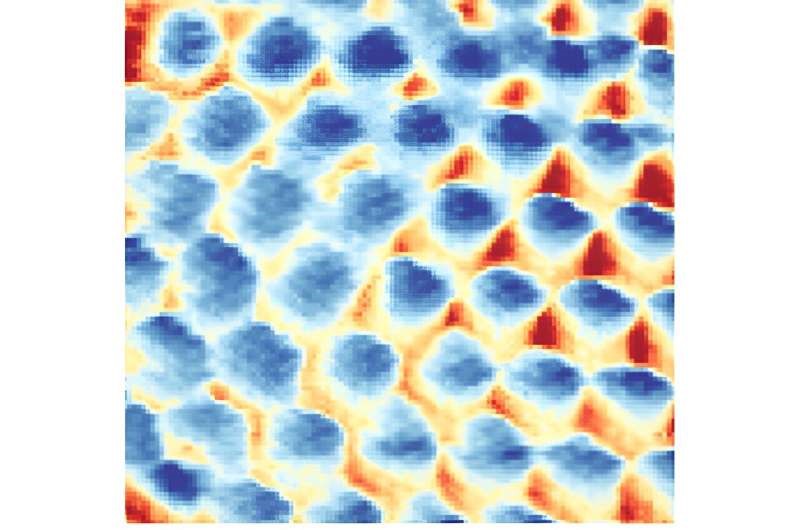Description

Source: Phys.org
Disclaimer: Copyright infringement not intended.
Context
- The discovery of a triangular Wigner crystal, made purely from the repulsive nature of electrons, represents a significant advancement in our understanding of quantum phenomena.
- Physicists at Princeton University used a scanning tunneling microscope (STM) to directly image the Wigner crystal for the first time.
Details
Observations
- Phase Transition: By tuning the electron density, researchers observed a phase transition where electrons spontaneously formed into a triangular Wigner crystal.
- Stability: Contrary to previous assumptions, the Wigner crystal was found to be stable over a wide range, with its lattice constant continuously tunable.
- Quantum Nature: The observed blurring of electron positions indicated strong zero-point motion, reflecting the quantum nature of the Wigner crystal
Significance of the Discovery
- Advancing Fundamental Physics: Direct visualization of the Wigner crystal confirms its existence and provides insights into collective electron behaviors.
- Potential Technological Applications: Understanding quantum phases of matter could lead to advancements in quantum computing and other technologies
About Wigner Crystal
- The Wigner crystal is a unique form of matter composed entirely of electrons arranged in a crystal-like formation due to their mutual repulsion.
- Named after Eugene Wigner, who proposed its existence in 1934.
Formation and Conditions:
- Coulomb Repulsion: Electrons repel each other due to their negative charge, leading to potential energy minimizing configurations.
- Low Density: Typically occurs in low-density systems where electron-electron interactions dominate.
- Low Temperatures: Formation favored at low temperatures where thermal energy is insufficient to disrupt the ordering.
Properties of Wigner Crystals:
- Long-Range Order: Electrons arrange themselves in a regular lattice structure.
- Reduced Mobility: Electrons are confined to lattice sites, reducing their mobility compared to a fluid state.
- Quantum Effects: Quantum mechanics play a significant role, especially at low temperatures and small length scales.
Applications:
- Quantum Computing: Understanding the behavior of Wigner crystals could provide insights into developing quantum computing architectures.
- Low-Dimensional Physics: Offers insights into the behavior of electrons in low-dimensional systems, relevant for nanotechnology and materials science.
- Fundamental Physics: Studying Wigner crystals helps elucidate the interplay between classical and quantum physics in many-body systems.

About Quantum Crystal
- Quantum crystals are materials where quantum effects dominate the behavior of particles within the crystal lattice.
- Quantum Effects: These effects can include quantum tunneling, zero-point energy, and quantum entanglement, among others.
- Properties: Quantum crystals often exhibit unusual properties such as superfluidity, superconductivity, and non-classical behavior at macroscopic scales.
Types of Quantum Crystals:
- Bose-Einstein Condensates (BECs): Ultra-cold gases of bosonic particles that condense into a single quantum state.
- Rydberg Crystals: Atoms in highly excited Rydberg states form a crystalline structure due to long-range interactions.
- Exciton Crystals: Crystals formed by excitons, bound electron-hole pairs, with strong quantum coupling.
- Supersolid Helium: Helium cooled to extremely low temperatures where it behaves as both a superfluid and a solid simultaneously.
- Other Potential Quantum Crystal Candidates: Theoretical predictions suggest the existence of other types of quantum crystals, but experimental verification is ongoing.
Properties of Quantum Crystals:
- Superfluidity: Some quantum crystals, like supersolid helium, exhibit frictionless flow, characteristic of superfluids.
- Superconductivity: Certain quantum crystals demonstrate zero electrical resistance at low temperatures, enabling efficient electrical conduction.
- Quantum Entanglement: Particles within quantum crystals may become entangled, displaying correlations that defy classical explanations.
- Quantum Tunneling: Particles tunnel through energy barriers, leading to unconventional transport properties.
- Zero-Point Energy: Even at absolute zero temperature, quantum crystals possess residual energy due to Heisenberg's uncertainty principle.
Applications:
- Quantum Computing: Quantum crystals may offer insights into designing novel quantum computing architectures and materials.
- Quantum Sensing: Utilizing the unique properties of quantum crystals for ultra-sensitive sensors and detectors.
- Quantum Information Processing: Harnessing quantum entanglement and tunneling for secure communication and information processing.
- Materials Science: Exploring the potential for new materials with tailored quantum properties for various technological applications.
Sources:
Phys.org
|
PRACTICE QUESTION
Q. Quantum crystals represent a cutting-edge area of research with profound implications for fundamental physics and practical applications in quantum technologies. Examine. (250 Words)
|











